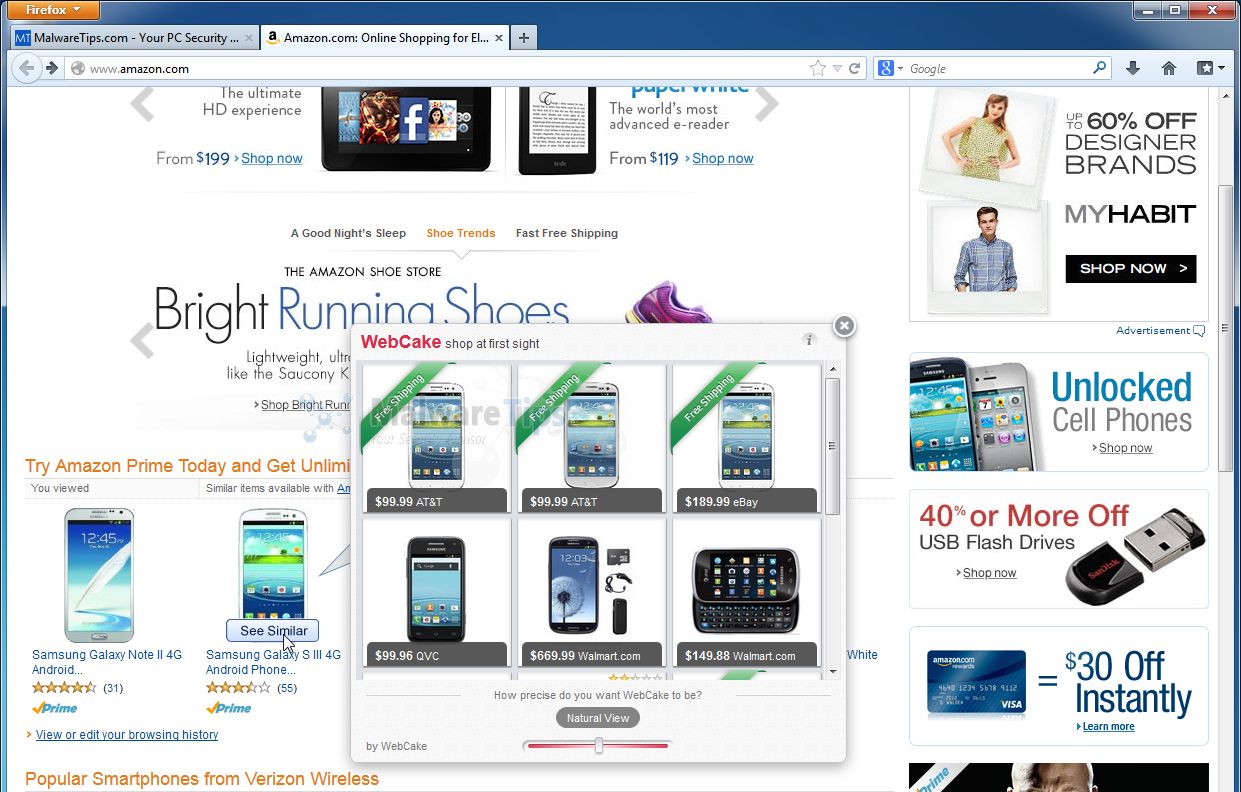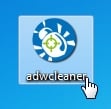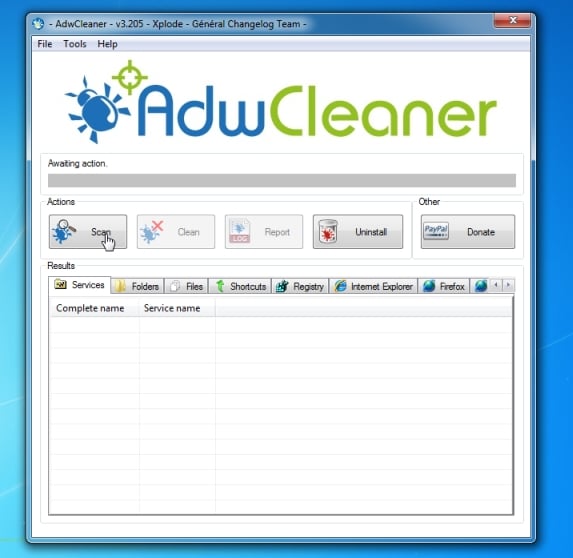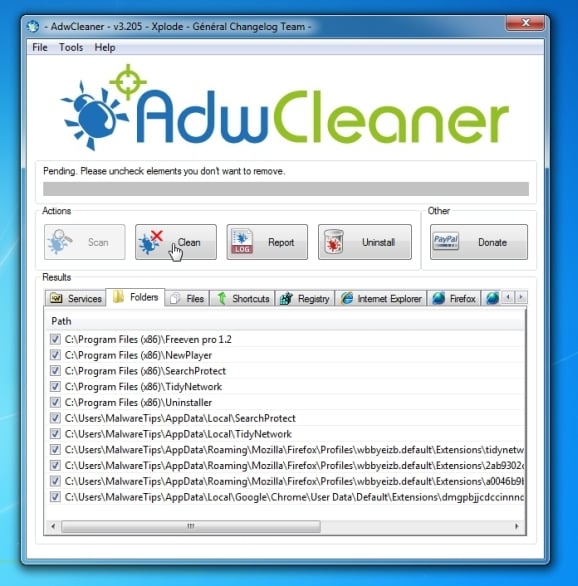Pop-up ads, or
advertising-supported software, is any software package which
automatically renders advertisements in order to generate revenue for
its author. The advertisements may be in the user interface of the
software or on a screen presented to the user during the installation
process. The functions may be designed to analyze which Internet sites
the user visits and to present advertising pertinent to the types of
goods or services featured there. The term is sometimes used to refer to
software that displays unwanted advertisements
![Browser Adware [Image: Browser Adware virus]](http://malwaretips.com/blogs/wp-content/uploads/2013/06/browser-adware.jpg)

Adware, or advertising-supported software, displays advertising banners or pop-ups on your computer when you use your Internet Browser (Internet Explorer, Mozilla Firefox, Google Chrome or Opera). This is not necessarily a bad thing. Such advertising can fund the development of useful software, which is then distributed free (for example, Android apps, many of which are adware funded).
However, adware becomes a problem if it:
- installs itself on your computer without your consent
- installs itself in applications other than the one
- it came with and displays advertising when you use those applications
- hijacks your web browser in order to display more ads
- gathers data on your web browsing without your consent and sends it to others via the Internet
- is designed to be difficult to uninstall
Adware can slow down your PC. It can also slow down your Internet
connection by downloading advertisements. Sometimes programming flaws in
the adware can make your computer unstable. Advertising pop-ups can
also distract you and waste your time if they have to be closed before
you can continue using your PC.
![Browser Popup Advertisement [Image: Browser Popup Advertisement ]](http://malwaretips.com/blogs/wp-content/uploads/2013/06/popup-advertisment.jpg)
Malware Adware are computer infections that are typically installed on your computer through two methods. The first method is when these Adware programs pretend to be something innocuous so that you will download and install them, but once installed all they do is display ads. The other method is when they are installed without your permission or knowledge through Windows or software vulnerabilities on your computer. Adware of this type are the most difficult to remove and typically use protection mechanisms that make it hard to run security programs to assist in removing them.
![Browser Popup Advertisement [Image: Browser Popup Advertisement ]](http://malwaretips.com/blogs/wp-content/uploads/2013/06/popup-advertisment.jpg)
Malware Adware are computer infections that are typically installed on your computer through two methods. The first method is when these Adware programs pretend to be something innocuous so that you will download and install them, but once installed all they do is display ads. The other method is when they are installed without your permission or knowledge through Windows or software vulnerabilities on your computer. Adware of this type are the most difficult to remove and typically use protection mechanisms that make it hard to run security programs to assist in removing them.
If your computer is infected with Adware or any other type of
malicious software, you can follow the below guide, and easily clean up
your infected computer.
How to remove Adware and pop-up ads (Removal Guide)
This page is a comprehensive guide, which will remove Pop-up Ads from Internet Explorer, Firefox and Google Chrome.
Please perform all the steps in the correct order. If you have any questions or doubt at any point,
Please perform all the steps in the correct order. If you have any questions or doubt at any point,
STOP and ask for our assistance.
STEP 1: Uninstall Pop-up Ads malicious programs from your computer
STEP 2: Remove Pop-up Ads from Internet Explorer, Firefox and Chrome
STEP 3: Remove Pop-up Ads adware with AdwCleaner
STEP 4: Remove Pop-up Ads browser hijackers with Junkware Removal Tool
STEP 5: Remove Pop-up Ads virus with Malwarebytes Anti-Malware Free
STEP 6: Double-check for the Pop-up Ads infection with HitmanPro
STEP 1: Uninstall Pop-up Ads malicious programs from your computer
STEP 2: Remove Pop-up Ads from Internet Explorer, Firefox and Chrome
STEP 3: Remove Pop-up Ads adware with AdwCleaner
STEP 4: Remove Pop-up Ads browser hijackers with Junkware Removal Tool
STEP 5: Remove Pop-up Ads virus with Malwarebytes Anti-Malware Free
STEP 6: Double-check for the Pop-up Ads infection with HitmanPro
STEP 1 : Uninstall Pop-up Ads program from your computer
Most Pop-up Adss will install a program on your computer, while this
is not a general rule, we will need to check for any malicious programs.
In this first step, we will try to identify and remove any malicious program that might be installed on your computer.
In this first step, we will try to identify and remove any malicious program that might be installed on your computer.
- To uninstall the program that has installed is responsible for the pop-up ads, click the Start button, then click on the Control Panel menu option.
![Control Panel in Windows Start Menu [Image: Control Panel in Windows Start Menu]](http://malwaretips.com/blogs/wp-content/uploads/2014/01/windows-start-menu-control-panel.jpg)
If you are using Windows 8, simply drag your mouse pointer to the right edge of the screen, select Search from the list and search for “control panel” .Or you can right-click on a bottom left hot corner (formerly known as the Start button) and select Control Panel from there.
![Type Control Panel in Windows 8 search box [Image: Control Panel in Windows 8]](http://malwaretips.com/blogs/wp-content/uploads/2014/01/control-panel-windows-8.jpg)
- When the Control Panel window opens click on the Uninstall a program option under Programs category. This option is shown by the arrow in the image below. If you are using the Classic View of the Control Panel, then you would double-click on the Programs and Features icon instead.
![Click on Uninstall a program [Image: Uninstall a program]](http://malwaretips.com/blogs/wp-content/uploads/2013/03/uninstall-a-program-windows.jpg)
- When the Programs and Features or the Uninstall a Program screen is displayed, scroll through the list of currently installed programs and uninstall AlllCheapPeruiCe 5.2, YoubeAdBlocker 1.2, TheBlooccker 1.3, Video Player, Plus-HD 1.3, BetterSurf, CouponMeApp, TubeAdblOCkER, BLoCkTheADApp 3.2, WatchItAdBlocake, Media Player 1.1, Savings Bull, Start Savin, Websteroids, ScorpionSaver, HD-Plus 3.5, Media Watch, Re-Markit, Remarkable, SupTab, Key-Find uninstaller, Feven Pro 1.2, HD-Plus, HD-Professional-HQ, Quick Share and any other recently installed unknown program from your computer.
To view the most recently installed programs, you can click on the “Installed On” column to sort your program by the installation date. Scroll though the list, and uninstall any unwanted or unknown programs
![Uninstall the program responsible for the pop-up ads [Image: Uninstall the program responsible for the pop-up ads]](http://malwaretips.com/blogs/wp-content/uploads/2014/02/Installed-by-enterprise-policy-removal.jpg)
Depending on what program has installed the adware infection, the above program may have a different name or not be installed on your computer. If you cannot find any unwanted or unknown programs on your machine, then you can proceed with the next step.
STEP 2 : Remove Pop-up Ads from Internet Explorer, Firefox and Chrome
Remove Pop-up Ads from Internet Explorer
You can reset Internet Explorer settings to return them to the state
they were in when Internet Explorer was first installed on your PC.
- Open Internet Explorer, click on the “gear icon”
![[Image: icongear.jpg]](http://malwaretips.com/images/removalguide/icongear.jpg) in the upper right part of your browser, then click again on Internet Options.
in the upper right part of your browser, then click again on Internet Options.
![Click on the Gear Icon then on Internet Options [Image: Internet Options in Internet Explorer]](http://malwaretips.com/blogs/wp-content/uploads/2014/03/Internet-Options-Internet-Explorer.jpg)
- In the “Internet Options” dialog box, click on the “Advanced” tab, then click on the “Reset” button.
![In the Advanced tab click on the Reset button [Image: Reset Internet Explorer]](http://malwaretips.com/blogs/wp-content/uploads/2014/03/Reset-Internet-Explorer.jpg)
- In the “Reset Internet Explorer settings” section, select the “Delete personal settings” check box, then click on “Reset” button.
![Click on the Reset button to revert IE to its default settings [Image: Reset Internet Explorer to its default settings]](http://malwaretips.com/blogs/wp-content/uploads/2014/03/reset-button-Internet-Explorer.jpg)
- When Internet Explorer has completed its task, click on the “Close”
button in the confirmation dialogue box. You will now need to close
your browser, and then you can open Internet Explorer again.
![Click on the Close button [Image Reset Internet Explorer settings]](http://malwaretips.com/blogs/wp-content/uploads/2014/03/Close-button-Reset.jpg)
Remove Pop-up Ads from Mozilla Firefox
If you’re having problems with Firefox, resetting it can help. The
reset feature fixes many issues by restoring Firefox to its factory
default state while saving your essential information like bookmarks,
passwords, web form auto-fill information, browsing history and open
tabs.
- In the upper-right corner of the Firefox window, click the Firefox menu button (
![Firefox Menu button [Image: Firefox Menu button]](http://malwaretips.com/blogs/wp-content/uploads/2014/04/Firefox-menu-button.png) ), the click on the “Help” (
), the click on the “Help” (![Firefox Help button [Image: Firefox Help button]](http://malwaretips.com/blogs/wp-content/uploads/2014/04/Firefox-Help.png) ) button.
) button.
If you’re unable to access the Help menu, type about:support in your address bar to bring up the Troubleshooting information page.
![Click on the Menu button then question mark button [Image: Click on the Menu button then Help]](http://malwaretips.com/blogs/wp-content/uploads/2014/04/Firefox-Help-button.jpg)
- From the Help menu choose Troubleshooting Information.
![Troubleshooting Information in Firefox [Image: Troubleshooting Information in Firefox]](http://malwaretips.com/blogs/wp-content/uploads/2014/04/Firefox-Troubleshooting-Information.jpg)
- Click the “Reset Firefox” button in the upper-right corner of the “Troubleshooting Information” page.
![Reset Firefox to its default settings [Image: Reset Firefox to its default settings]](http://malwaretips.com/blogs/wp-content/uploads/2014/04/Reset-Firefox-button.jpg)
- To continue, click on the “Reset Firefox” button in the new confirmation window that opens.
![Click on the Reset Firefox button [Image: Click on the Reset Firefox button]](http://malwaretips.com/blogs/wp-content/uploads/2014/04/Reset-Firefox-to-default-settings.jpg)
- Firefox will close itself and will revert to its default settings. When it’s done, a window will list the information that was imported. Click on the “Finish“.
Note: Your old Firefox profile will be placed on your desktop in a folder named “Old Firefox Data“.
If the reset didn’t fix your problem you can restore some of the
information not saved by copying files to the new profile that was
created. If you don’t need this folder any longer, you should delete it
as it contains sensitive information.
Remove pop-up ads from Google Chrome
- Click on Chrome’s main menu button, represented by three horizontal lines (
![Google Chrome's main menu button [Image: Chrome's main menu button]](http://malwaretips.com/blogs/wp-content/uploads/2014/02/reset-Chrome-button.png) ) .When the drop-down menu appears, select the option labeled Settings.
) .When the drop-down menu appears, select the option labeled Settings.
![Click on Settings button [Image: Click on Settings button]](http://malwaretips.com/blogs/wp-content/uploads/2014/02/Reset-Chrome-Settings-1.jpg)
- Chrome’s Settings should now be displayed in a new tab or window,
depending on your configuration. Next, scroll to the bottom of the page
and click on the Show advanced settings link (as seen in the below example).
![Click on Show advanced settings link [Image: Click on Show advanced settings link]](http://malwaretips.com/blogs/wp-content/uploads/2014/02/Reset-Chrome-Settings-2.jpg)
- Chrome’s advanced Settings should now be displayed. Scroll down until the Reset browser settings section is visible, as shown in the example below. Next, click on the Reset browser settings button.
![Click on Reset browser button [Image: Click on Reset browser button]](http://malwaretips.com/blogs/wp-content/uploads/2014/02/Reset-Chrome-Settings-3.jpg)
- A confirmation dialog should now be displayed, detailing the
components that will be restored to their default state should you
continue on with the reset process. To complete the restoration process,
click on the Reset button.
![Click on Reset button to restore Chrome to default settings [Image: Click on Reset button to restore Chrome to default settings]](http://malwaretips.com/blogs/wp-content/uploads/2014/02/Reset-Chrome-Settings-4.jpg)
STEP 3: Remove Pop-up Ads adware from your computer with AdwCleaner.
The AdwCleaner utility will scan your computer and web browser for
malicious files, adware browser extensions and registry keys, that may
have been installed on your computer without your knowledge.
- You can download AdwCleaner utility from the below link.
ADWCLEANER DOWNLOAD LINK (This link will automatically download AdwCleaner on your computer) - Before starting AdwCleaner, close all open programs and internet browsers, then double-click on the AdwCleaner icon.

If Windows prompts you as to whether or not you wish to run AdwCleaner, please allow it to run. - When the AdwCleaner program will open, click on the “Scan” button as shown below.

AdwCleaner will now start to search for the any malicious files that may be installed on your computer. - To remove the malicious files that were detected in the previous step, please click on the “Clean” button.

- AdwCleaner will now prompt you to save any open files or documents, as the program will need to reboot the computer. Please do so and then click on the OK button.

STEP 4: Remove Pop-up Ads browser hijacker with Junkware Removal Tool
Junkware Removal Tool is a powerful utility, which will remove Pop-up
Ads redirect from Internet Explorer, Firefox or Google Chrome.
- You can download the Junkware Removal Tool utility from the below link:
JUNKWARE REMOVAL TOOL DOWNLOAD LINK (This link will automatically download the Junkware Removal Tool utility on your computer) - Once Junkware Removal Tool has finished downloading, please double-click on the JRT.exe icon as seen below.
![Double-click on the Junkware Removal Tool utility [Image: Junkware Removal Tool]](http://malwaretips.com/blogs/wp-content/uploads/2013/06/Junkware-icon.jpg)
If Windows prompts you as to whether or not you wish to run Junkware Removal Tool, please allow it to run. - Junkware Removal Tool will now start, and at the Command Prompt, you’ll need to press any key to perform a scan for the Pop-up Ads hijacker.
![Junkware Removal Tool scanning for Pop-up Ads pop-up virus [Image: Junkware Removal Tool scanning for Pop-up Ads virus]](http://malwaretips.com/blogs/wp-content/uploads/2013/06/junkware-removal-tool.jpg)
Please be patient as this can take a while to complete (up to 10 minutes) depending on your system’s specifications. - When the scan Junkware Removal Tool will be completed, this utility
will display a log with the malicious files and registry keys that were
removed from your computer.
![Junkware Removal Tool final log [Image: Junkware Removal Tool final log]](http://malwaretips.com/blogs/wp-content/uploads/2013/06/Junkware-log.jpg)
STEP 5: Remove Pop-up Ads virus with Malwarebytes Anti-Malware FREE
Malwarebytes Anti-Malware Free uses industry-leading technology to
detect and remove all traces of malware, including worms, Trojans,
rootkits, rogues, dialers, spyware, and more.
It is important to note that Malwarebytes Anti-Malware works well and should run alongside antivirus software without conflicts.
It is important to note that Malwarebytes Anti-Malware works well and should run alongside antivirus software without conflicts.
- You can download download Malwarebytes Anti-Malware from the below link.
MALWAREBYTES ANTI-MALWARE DOWNLOAD LINK (This link will open a new web page from where you can download Malwarebytes Anti-Malware Free) - Once downloaded, close all programs, then double-click on the icon on your desktop named “mbam-setup-consumer-2.00.xx” to start the installation of Malwarebytes Anti-Malware.
![Malwarebytes Anti-Malware setup program [Image: Malwarebytes Anti-Malware setup program]](http://malwaretips.com/blogs/wp-content/uploads/2014/02/Malwarebytes-Anti-Malware-Setup.jpg)
 You may be presented with a User Account Control dialog asking you if
you want to run this file. If this happens, you should click “Yes” to continue with the installation.
You may be presented with a User Account Control dialog asking you if
you want to run this file. If this happens, you should click “Yes” to continue with the installation. - When the installation begins, you will see the Malwarebytes Anti-Malware Setup Wizard which will guide you through the installation process.
![Malwarebytes Anti-Malware Setup Wizard [Image: Malwarebytes Anti-Malware Setup Wizard]](http://malwaretips.com/blogs/wp-content/uploads/2014/02/malwarebytes-anti-malware-2-0-installation.jpg)
To install Malwarebytes Anti-Malware on your machine, keep following the prompts by clicking the “Next” button.
![Malwarebytes Anti-Malware Final Setup Screen [Image: Malwarebytes Anti-Malware Final Setup Screen]](http://malwaretips.com/blogs/wp-content/uploads/2014/02/malwarebytes-anti-malware-2-0-final-screen.jpg)
- Once installed, Malwarebytes Anti-Malware will automatically start
and you will see a message stating that you should update the program,
and that a scan has never been run on your system. To start a system
scan you can click on the “Fix Now” button.
![[Image: Click on the Fix Now button to start a scan]](http://malwaretips.com/blogs/wp-content/uploads/2014/02/malwarebytes-anti-malware-fix-now.jpg)
Alternatively, you can click on the “Scan” tab and select “Threat Scan“, then click on the “Scan Now” button.
![Malwarebytes Anti-Malware Threat Scan [Image: Malwarebytes Anti-Malware Threat Scan]](http://malwaretips.com/blogs/wp-content/uploads/2014/02/malwarebytes-anti-malware-threat-scan-option.jpg)
- Malwarebytes Anti-Malware will now check for updates, and if there are any, you will need to click on the “Update Now” button.
![Click on Update Now to update Malwarebytes Anti-Malware [Image: Click on Update Now to update Malwarebytes Anti-Malware]](http://malwaretips.com/blogs/wp-content/uploads/2014/02/malwarebytes-anti-malware-2-0-update-now.jpg)
- Malwarebytes Anti-Malware will now start scanning your computer for
the pop-up virus. When Malwarebytes Anti-Malware is scanning it will
look like the image below.
![Malwarebytes Anti-Malware while performing a scan [Image: Malwarebytes Anti-Malware while performing a scan]](http://malwaretips.com/blogs/wp-content/uploads/2014/02/malwarebytes-anti-malware-scan.jpg)
- When the scan has completed, you will now be presented with a screen
showing you the malware infections that Malwarebytes’ Anti-Malware has
detected. To remove the malicious programs that Malwarebytes
Anti-malware has found, click on the “Quarantine All” button, and then click on the “Apply Now” button.
![Remove the malware that Malwarebytes Anti-Malware has detected [Image: Remove the malware that Malwarebytes Anti-Malware has found]](http://malwaretips.com/blogs/wp-content/uploads/2014/02/malwarebytes-anti-malware-potential-threat-detected.jpg)
Please note that the infections found may be different than what is shown in the image. - Malwarebytes Anti-Malware will now quarantine all the malicious
files and registry keys that it has found. When removing the files,
Malwarebytes Anti-Malware may require a reboot in order to remove some
of them. If it displays a message stating that it needs to reboot your
computer, please allow it to do so.
![Malwarebytes Anti-Malware asking to reboot your computer [Image: Malwarebytes Anti-Malware while removing viruses]](http://malwaretips.com/blogs/wp-content/uploads/2014/02/malwarebytes-anti-malware-remove-virus.jpg)
After your computer will restart, you should open Malwarebytes Anti-Malware and perform another “Threat Scan” scan to verify that there are no remaining threats
STEP 6: Double-check for the Pop-up Ads infection with HitmanPro
HitmanPro is a second opinion scanner, designed to rescue your
computer from malware (viruses, trojans, rootkits, etc.) that have
infected your computer despite all the security measures you have taken
(such as anti virus software, firewalls, etc.). HitmanPro is designed to
work alongside existing security programs without any conflicts. It
scans the computer quickly (less than 5 minutes) and does not slow down
the computer.
- You can download HitmanPro from the below link:
HITMANPRO DOWNLOAD LINK (This link will open a new web page from where you can download HitmanPro) - Double-click on the file named “HitmanPro.exe” (for 32-bit versions of Windows) or “HitmanPro_x64.exe” (for 64-bit versions of Windows). When the program starts you will be presented with the start screen as shown below.
![HitmanPro startup screen (Click Next) [Image: HitmanPro start-up screen]](http://malwaretips.com/blogs/wp-content/uploads/2014/03/hitmanpro-install.jpg)
Click on the “Next” button, to install HitmanPro on your computer.
![HitmanPro installation options (Click Next) [Image: HitmanPro setup options]](http://malwaretips.com/blogs/wp-content/uploads/2014/03/hitmapro-start-scan.jpg)
- HitmanPro will now begin to scan your computer for any malicious files that may be on your machine.
![HitmanPro scanning for pop-up virus [Image: HitmanPro scanning for malware]](http://malwaretips.com/blogs/wp-content/uploads/2014/03/hitmanpro-scanning.jpg)
- When it has finished it will display a list of all the malware that
the program found as shown in the image below. Click on the “Next” button, to remove any virus that has been found.
![HitmanPro scan results (Click Next) [Image: HitmanPro scan results]](http://malwaretips.com/blogs/wp-content/uploads/2014/03/hitmanpro-scan-results.jpg)
- Click on the “Activate free license” button to begin the free 30 days trial, and remove all the malicious files from your computer.
![[Image: HitmanPro Activate Free License]](http://malwaretips.com/blogs/wp-content/uploads/2014/03/hitmanpro-activation.jpg)
Your computer should now be free of the Pop-up Ads infection. If your
current anti-virus solution let this infection through, you may want to
consider purchasing the Premium version of Malwarebytes Anti-Malware to protect against these types of threats in the future.
If you are still experiencing problems while trying to remove Pop-up Ads from your Computer, Please do comment below:
If you are still experiencing problems while trying to remove Pop-up Ads from your Computer, Please do comment below:

No comments:
Post a Comment
PLEASE DO COMMENT